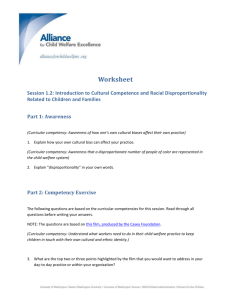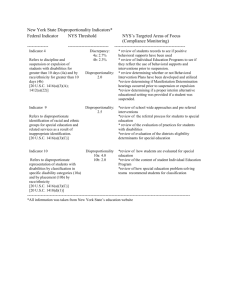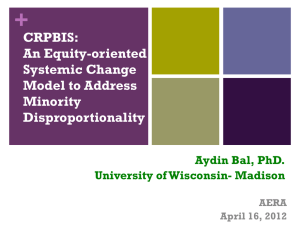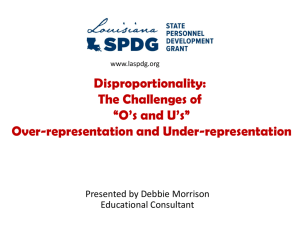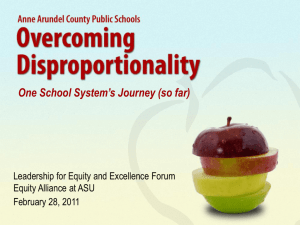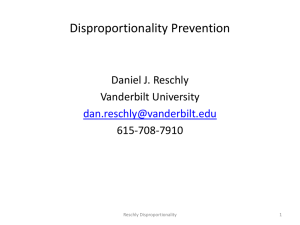Cultural Responsivity
advertisement
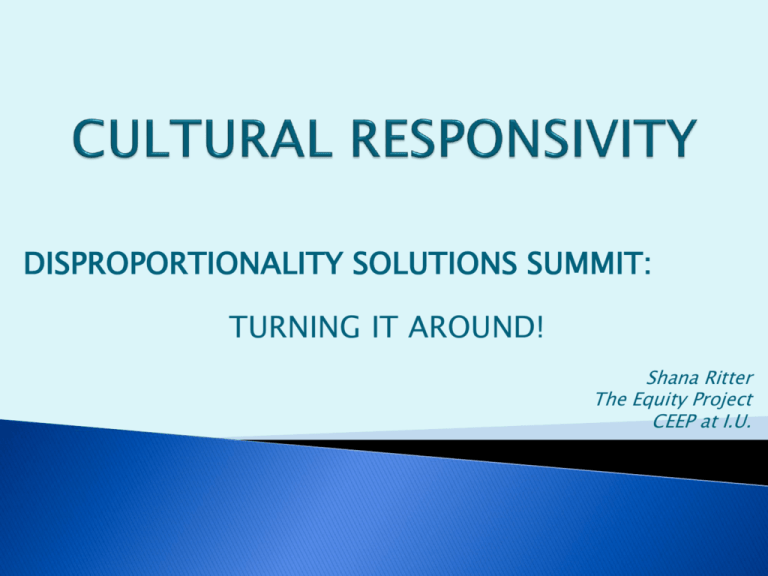
DISPROPORTIONALITY SOLUTIONS SUMMIT: TURNING IT AROUND! Shana Ritter The Equity Project CEEP at I.U. A principle that guides policy and practice holding high expectations and providing appropriate resources so that all students can achieve at a rigorous standard. A developmental process. A set of congruent behaviors, attitudes and policies that come together in a system, agency or among professionals to work effectively in cross-cultural situations. Having the capacity to function effectively in cultural contexts that differ from your own. Cultural responsivity facilitates the achievement of all students through effective teaching and learning practices grounded in an awareness of cultural context and the strengths that students bring to school. Cultural responsivity permeates every aspect of education: curriculum and instruction assessment data based decision making communication family and community engagement policy decisions Becoming culturally responsive is a developmental process which includes engaging in conversations about race and equity, reflecting on one’s own culture and beliefs, and gaining awareness of other cultures. Cultural Competence Continuum Destructiveness Pre-Competence Incapacity Competence Proficiency Valuing Diversity is a necessary step along the continuum of cultural competency and culturally responsive pedagogy, but it is not enough. Cultural Responsivity requires knowledge, skills and experience and the ability to transform these into practice which results in improved services and outcomes. 1. An understanding of your cultural identity. ◦ What do you value? ◦ What is your style of communication? ◦ What are your strengths and challenges around teaching and learning? ◦ What are your expectations? 2. An understanding of your student’s cultural identity. ◦ What do they value? ◦ What is their style of communication? ◦ What are their strengths and challenges around teaching and learning? ◦ What are their expectations? Nationality Class Religion Race Gender Age Education Ethnicity Ability Family Geography Profession Sexual Orientation 3. Understanding what happens when different cultures intersect. How do you capitalize on cultural capitol? How do you bridge differences? How do you create access to opportunities? Disproportionality Disproportionality Disproportionality Disproportionality in in in in Achievement Discipline High School Graduation Special Education National NAEP Percent Scoring Basic or Above: 2003 Percent Basic and Above Grade 4 Reading 80 80 Percent Basic and Above Grade 8 Mathematics 78 79 74 69 70 70 60 60 47 50 54 46 50 42 40 39 40 40 30 30 20 20 10 10 0 0 Black Asian Latino Native Am White Black Asian Hispanic Native Am White National Graduation Rates by Race in 2002 90% 79% 80% 76% 69% 70% 60% 57% 55% Percentage 53% Native American Asian Hispanic African-American White Total 50% 40% 30% 20% 10% 0% 1 Race Manhattan Institute for Policy Research, 2002 National School Discipline: 2002-2003 2.84 3.00 2.47 Relative Risk Ratio (Compared to White Students) 2.50 2.00 1.50 Out-of-School Suspension 1.23 1.50 1.00 Expulsion Equity Line 0.50 0.00 Black Hispanic Note: Derived from U.S. Department of Education, 2004 In addition to the problems the students experience in their personal lives away from school, the schools create a whole new set of problems for children they deem different. As schools become more wedded to psychological models, students are recruited into new categories of pathology. Students who do not conform to particular behavioral expectations may be labeled "disabled" in some way, that is, suffering from attention deficit disorder, emotional disability, or cognitive disabilities. Students do in fact confront real mental and emotional problems, but we need to consider the way students' racial, ethnic, cultural, linguistic, and socioeconomic characteristics are deployed to make their assignments to these disability categories more likely. Gloria Ladson Billings ◦ ◦ ◦ ◦ ◦ ◦ ◦ Mild Mental Disability 3.29 x more Emotional Disturbance 2.38 x more Moderate MD 1.91 x more Communication Disorder 35% less Learning Disabled 6% less Regular Class Placement 35% less Separate Class Placement. 2.84 x more ◦ African American students with a disability are 35% less likely than their peers to be served in a general education setting ◦ African American students with a disability are 2.84 times more likely than their peers to served in a separate class placement Poverty not a consistent predictor of placement ◦ ◦ ◦ Overall, MoMD and ED: Not significant CD and LD: More disproportionality as poverty decreased MiMD: Positive and significant Race is a significant predictor of special education placement regardless of (independent of) poverty level ◦ Poverty magnifies the gap created by race Skiba, R. J., Poloni-Staudinger. L., Simmons, A. B., Feggins, L. R., & Chung, C. G. (2005). Unproven links: Can poverty explain ethnic disproportionality in special education? Journal of Special Education, 39, 130-144. People Practices Policies Facilitates and supports the achievement of all students through cultural competency at three levels: The Institutional The Personal The Instructional (a) (b) In developing a school's strategic and continuous school improvement and achievement plan under IC 20-10.2-3, the school's committee shall consider methods to improve the cultural competency of the school's teachers, administrators, staff, parents, and students. The committee shall: (1) identify the racial, ethnic, language-minority, cultural, exceptional learning, and socioeconomic groups that are included in the school's student population; (2) incorporate culturally appropriate strategies for increasing educational opportunities and educational performance for each group in the school's plan; and (3) recommend areas in which additional professional development is necessary to increase cultural competency in the school's educational environment. “I thought it was wrong to see color. Like the tshirts- “Love sees no color”. As I’ve come to understand you’re missing a big part of a person if you refuse to see it” – elementary school teacher “When a teacher doesn’t see color do they also ignore discriminatory institutional practices such as disproportionality in suspension, graduation, achievement etc…..?” Engage in reflective practice Explore personal and family histories Acknowledge membership in different groups Learn about the history and experiences of diverse groups Visit students’ families and communities Visit or read about successful teachers in diverse settings Participate in reforming the institution “When instruction is stripped of children’s cultural legacies then they are forced to believe that the world and all the good things in it were created by others. This leaves students further alienated from the school and its instructional goals, and more likely to view themselves as inadequate.” Acknowledge students’ differences as well as their commonalities Validate students’ cultural identity in classroom practices and instructional materials Educate students about the diversity of the world around them Promote equity and mutual respect Assess students’ ability and achievement validly Encourage students to think critically Challenge students to strive for excellence “Multicultural education needs to be accompanied by a deep commitment to social justice and equal access to resources…, in short it needs to be about much more than ethnic tidbits and cultural sensitivity.” “It is easier to adopt a multicultural reader than to assure all children learn to read, to have a concert of ethnic music than to give all children instruments.” Who’s taking calculus? Which classes meet in the basement? Who’s teaching the children? How much are children worth? Have we considered a range of possible hypotheses? Have we dug into the data? Is our process culturally responsive? Who is not at the table? % % "Adolescents play pranks. I don’t think it was a threat against anybody.” --Roy Breithaupt, Superintendent, Jena Public Schools, 2006 “[The noose] meant the KKK, it meant 'We're going to kill you, we're gonna' hang you 'til you die.'” --Caseplia Bailey, Parent of one of Jena 6 students If our examination and understanding of the root causes of social inequality are too shallow, then our approach to corrective action will necessarily be superficial and ineffective . - Christine Sleeter R.D. Laing stated crazy is believing that you can continue to repeat the same actions and arrive at different results. Relevant data Probing questions Examining beliefs about school culture and equity ◦ Issues of access ◦ Opportunities to learn ◦ Expectations of students, staff and community LOCALEQUITYACTION DEVELOPMENT PROJECTS ONGOING QUESTIONS What do weknow about disproportionality in our district? What changesin school-basedprocesses will have the greatest impact on disproportionality in our schools? How do we involve othersin the processof creating ownership for and bringing about change? How will weknowif our efforts are working? What impact will this have on other issuesof equity? PROCESSSTEPS Form a Planning Team Form a preliminary planning team Review existing data Name the issue Expand th e planning team to include other key district stakeholders Gather and analyzenew information Identify the Action of Greatest PotentialImpact Develop a Plan Designa LEADpilot Hold focus groupsto examine the issue and possible actions Examine anddiscuss input from th e focus groups Gather research and information on best practicesand models Engage in honest conversations about expectations for ALL students and staff Implement, Assess, Adapt Expand th e team to include representatives from all sites to assuretwo-way communication Provide pro fessional development , time, and other supports Provide pro fessionaldevelopment as needed or f bestpractice Developan Action Plan for Implementation Clarify links andcommunicate with other district initiatives and ELL, Title, SchoolImprovement etc. Pilot in afew places Use data consistently Gather feedback Deepen conversations aboutequity and culturally responsive dagogy pe Adapt th e pilot Include pa rents and community Plan for expanded implementation Ongoing asses smentscontinueto informimplementation In order to address the complexity of disproportionality issues in a way that is meaningful and appropriate to the culture of that district, plans must originate from within the district. While center staff provide guidance and technical assistance, decisions on plan design and implementation are made by the district LEAD team. Local data on equity provide a framework that can motivate and guide local remediation efforts. The success of any systems change efforts can be judged only by changes in those data. Conversations about race, disproportionality, and equity are awkward and often difficult, but necessary. Part of the role of the team is to ensure that team meetings are a safe place for having honest and “courageous” conversations, where common understandings can be created. Overall MiMH ED LD Reg. Class Resource Sep. Class Statewide Non-LEAD -.03% -6.7% +2.0% +12.4% +7.4% +19.2% +16.5% +0.3% -2.2% -2.4% +17.9% +3.1% +21.3% +29.9% Most Active LEAD Districts -19.3% -18.9% -4.2% +3.9% +5.1% +35.4% -1.9% Data is an integral part of the process when a school is willing to ask itself about the expectations it holds for children and about culture and power it begins to bring accountability for equity inside. Conversing about issues of equity, especially race, is a developmental process; ample time to build trust is necessary. It is by questioning assumptions that a leader is able to influence change. Leadership that is willing to examine their own beliefs, and empower those they work with to do the same, is essential to the process of creating equitable change. Ownership of the process grows through action: ongoing dialogue with colleagues, gaining a deeper understanding of the issues, design, implementation, and assessment. Addressing issues of equity is more likely to be ongoing: When it is viewed as an effort that benefits all children. When incorporated into the district’s overall plans for school improvement and other initiatives. When the community is involved. The disproportionality of students of color in educational programs cannot be fully comprehended as long as it is considered a singular event, somehow divorced from the broader context of American education and American society. Three key facets of cultural responsivity: Know your own cultural identity. Gain an awareness of the cultural identity of your students and their families. Form an understanding of what happens when different cultures intersect, and capitalize on the energy of what can happen. “The world changes according to the way people see it, and if you can alter, even by a millimeter, the way people look at reality, then you can change the world.” James Baldwin Shana Ritter rritter@indiana.edu 812 855 8563

